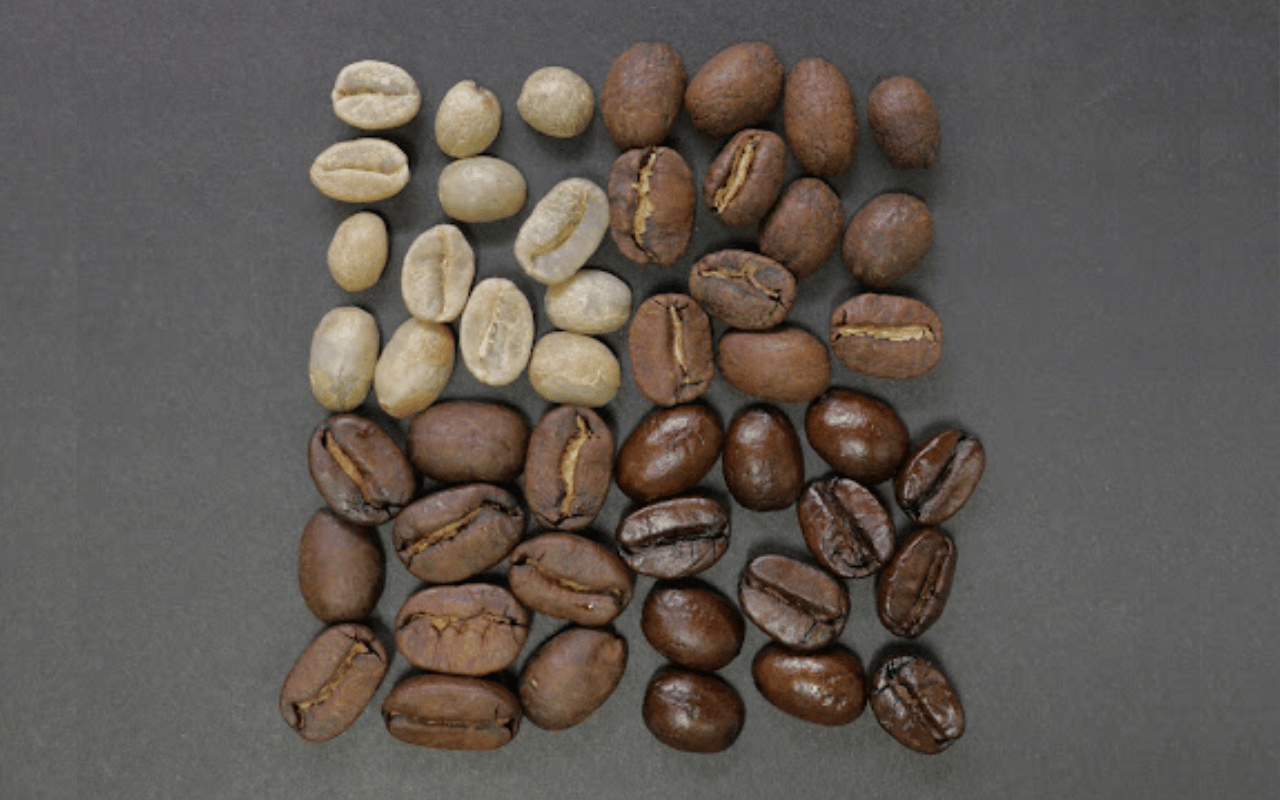For centuries, coffee has captivated and energized people across the globe. But hidden behind its familiar roasted aroma are a diverse array of beans, each with its own unique story and taste profile. Come along as we travel through the coffee-growing world, get to know the four main types of coffee beans, and uncover some fascinating tales of smuggling, romance, and serendipity behind the bean.
Arabica beans – More popular, sweeter and softer flavor
Robusta beans – Stronger in taste, higher caffeine
Liberica beans – Rare, full-bodied flavor
Excelsa beans – Tart, fruity, almost citrusy
Robusta Coffee Beans
Our next stop in types of coffee beans takes us to Robusta country – the workhorse type of coffee bean that powers instant coffee and espresso blends across the globe. Robusta thrives in low-lying regions with sweltering heat and high humidity. Unlike delicate Arabica, Robusta trees are hardy, vigorous, and resistant to pests and disease. Major producers include Brazil, Vietnam, Indonesia, and Uganda.
The Robusta bean contains nearly twice as much caffeine as Arabica. Its flavor is harsher and grainier, with earthy, peanutty notes. An acquired taste on its own, it blends well with milder beans. Think of Robusta as the strong, silent type of the coffee beans world – powering everyday caffeinated drinks without fanfare or frills.

What Exactly is Robusta Coffee?
Robusta coffee has about 40% of the coffee market and is considered one of the most popular types of coffee beans. The trees of this coffee are stout and strong, which makes them show relatively good resistance in harsh conditions. It is necessary to say that if you like coffee and the amount of caffeine is important to you, this type of coffee bean is the best choice and has the highest amount of natural caffeine among all the beans.
Where & How Are Robusta Coffee Beans Grown?
This type of coffee bean is the seed of the canephora plant and is grown from this plant.
Robusta is mainly grown in the Eastern Hemisphere in countries such as Africa and Brazil, where Indonesia has been able to claim the title of the largest Robusta producer. This seed is usually used to prepare espresso and instant coffee, and it offers an excellent taste.
The robusta tree is resistant to sunlight (30 degrees Celsius and above), it also needs a lot of water, and it quickly dies without enough water. Another feature of this tree is its high resistance to insects and diseases. In nature, they grow up to 10 meters, but for cultivation, they are 5 meters, so harvesting is easier. The flower smell of this tree is relatively similar to jasmine flowers. Its seeds need 6 to 8 months to grow fully.
Taste of Robusta Coffee Beans
About its taste, it can be said that it is a little earthy and a little plastic with moderate bitterness and leaves traces of peanuts after drinking. The taste of Robusta is largely related to the quality of seed cultivation; for example, the smell of potatoes can be felt in poor-quality seeds. Compared to Arabica, it has a stronger taste due to less sugar.
Read More: Benefits of Robusta Coffee
Types of Coffee Beans Arabica
The fourth main type of coffee bean is none other than Arabica, the coffee connoisseur’s type of coffee bean of choice. Accounting for 60% of global output, Arabica’s sweet, delicate flavor has made it the world’s most popular coffee. It first emerged from the aromatic coffee forests of Ethiopia and Yemen. And while Brazil is the top grower today, you’ll find Arabica cultivated throughout Latin America and Africa as well.
Unlike hardy Robusta, Arabica prefers high altitudes, cool climates, rich soil, and ample rainfall. It is more susceptible to pests, disease, and drought. But Arabica yields a far more complex and nuanced brew when grown under optimal conditions. Notes span from sweet and fruity to bright, clean acidic floral. From morning brew to gourmet roast, Arabica satisfies both discerning and everyday coffee lovers.

What Exactly is Arabica Coffee?
Arabica coffee has not changed much for many years because of its many sprays, and it can be said that it is the most stable coffee and it has not changed much since the first time this plant was discovered. One of the interesting points is that it can reduce the possibility of getting cancer and prevent Alzheimer’s disease.
Read More: Why is it Called Arabica?
Where & How Are Arabica Coffee Beans Grown?
According to its name, it is easy to guess that this type of coffee bean belongs to Arab countries; for example, it grows in the mountainous regions of Yemen, southwestern Ethiopia, southeastern Sudan, and Guatemala. When this coffee tree starts growing, it can reach a height of 40 feet. Having an open-branching system makes the leaf uniform and shiny. It grows at about 1000 to 2000 meters above sea level and is highly sensitive to heat and vulnerable to pests.
Taste of Coffee Arabica Beans
In terms of taste, it can be said that it has the same characteristics as the previous coffee; that is, the taste of earth and a little plastic is still there, but here the sourness is very slightly noticeable.
Read More: Benefits of Arabica Coffee
Excelsa Coffee Beans
Our first stop in different types of coffee beans is Excelsa, a rare type of coffee bean hailing from central Africa that accounts for just 7% of global production. Excelsa was first discovered near Lake Chad in Chad during the early 1900s. Though Excelsa thrives in hot, tropical areas, Chadians were the first to cultivate it as a commercial crop. Neighboring countries like Uganda, Ethiopia, and the Central African Republic later followed suit.
The Excelsa tree yields small, tapered beans that prove tricky to harvest. The flavor is often described as tart and earthy, with strong aromas but less caffeine than other varieties. Beyond Africa, Excelsa is also grown in Southeast Asia – yet it remains relatively obscure. Most Excelsa beans end up blended with more popular varieties like Arabica to lend a unique twist.

What exactly is Excelsa Coffee?
This type of coffee bean is easier to grow because they don’t need special soil or a lot of water. Also, this type of coffee bean is not one of the popular coffees, and it consumes less than its competitors, so some researchers believe that this plant is wrongly classified.
Where & How Are Excelsa Coffee Beans Grown?
Excelsa coffee plants were discovered around Lake Chad in Chad in the 1900s. The coffee cultivation industry is one of the main sources of income for the people and farmers of Chad.
Although the country that discovered this type of coffee is Chad, this coffee is found in countries like Indonesia, Vietnam, Central African Republic, Liberia, the Philippines, and Sierra Leone it is also cultivated.
Taste of Excelsa Coffee Beans
It is not easy to explain the taste of this coffee Because it was usually not served alone due to its unbearable taste, and it was eaten with the help of other coffees and mixed with them. Those who test this coffee say it has a strong earthy taste and a strong coffee smell, which is not interesting to them. Many people like and drink coffee because of its caffeine, and it should be noted that the caffeine in this coffee is naturally less than the others.
Liberiac Coffee Beans
Our next stop in types of coffee beans is the steamy country of Liberia, home of aromatic Liberica coffee. Liberica is instantly recognizable by its towering trees, massive leaves, and clustered fruit. It is a tropical plant that prefers humid conditions, though significant growers include Malaysia, Indonesia, and the Philippines.
Throughout the 1800s, Liberica was one of the few sources of coffee globally. But at under 2% of current production, Liberica is now rare. Its scarcity comes down to the tree’s size – the berries can reach heights of up to 23 feet! Mechanical harvesting is nearly impossible. Nonstop manual labor and low yields mean Liberica beans command premium prices.
Beyond harvesting challenges, Liberica has faced tremendous hurdles. Political instability ravaged the country and its coffee industry for decades. Disease swept through plantations in the 1980s, devastating yields. And consumers tend to find Liberica’s pungent, smoky flavor profile an acquired taste – though some liken it to earthy cocoa. Yet devotees are keeping the mellow, complex Liberica tradition alive.

What exactly is Liberica Coffee?
Liberica plants are larger than other coffees because of their rich wood and smoky taste. Just like the previous coffee, this coffee is not very popular among coffee lovers. One point that makes this type of coffee bean special is that it only accounts for 2% of the world’s coffee production. This has a clear reason, the difficulty of harvesting due to its height and processing.
The problem of harvesting is so serious that people are planting and growing labyrinth plants, which has endangered our desired coffee. The beginning of the extinction process of this plant goes back to 1980 when it was mostly cultivated, and due to the spread of a fungal infection, its extinction started.
Where & How Are Liberica Coffee Beans Grown?
These Liberica plants grow and originate in Liberia, a country on the west coast of Africa. Unlike the previous coffee, this type of coffee bean needs special conditions and weather to grow. Due to its limited supply, Labrica coffee is considered one of the most expensive coffees.
Read More: The Origin of Coffee
Taste of Liberica Coffee Beans
Like the one above, Liberica coffee is a little high in caffeine, but it makes up for it with its excellent aroma. Lovers of this coffee describe its aroma as nutritive and smoky with a slight trace of chocolate, So that some even compare it with the tobacco plant. This type of coffee bean is not more bitter than its competitors, Arabica and Robusta, but it has a stronger taste.
Conclusion
This journey through the world of coffee shows that there is incredible diversity behind each cup. From the rare earthiness of Excelsa to the brute strength of Robusta, each variety adds an irreplaceable thread. Coffee’s past is colored with adventure, from intrepid explorers discovering remote beans to star-crossed smugglers spreading sacred seeds. Its future promises continued fascination as new brewing techniques unlock hidden dimensions. But the constant is coffee’s hold on our senses and rituals. Let us revel in coffee’s richness, savor its diversity, and marvel at the journey from seed to cup. The adventure has only just begun.

